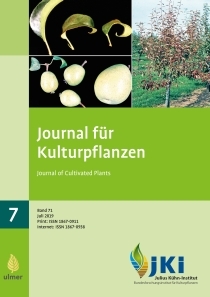Detection of ‘Candidatus Phytoplasma pyri’ (pear decline agent) in pear trees by different diagnostic procedures in the seasonal course
DOI:
https://doi.org/10.5073/JfK.2019.07.01Keywords:
nested PCR, real-time PCR, real-time LAMP, sample size, sampling date, pear cultivarAbstract
The influence of three nucleic acid-based detection procedures and two sample sizes on the detection rate of ‘Candidatus Phytoplasma pyri’ (pear decline agent) was studied in a factorial trial with three pear cultivar/rootstock combinations in the course of the year. Shoot samples were taken approximately every month over a period of 17 months from naturally infected trees. Nested PCR (nPCR), real-time LAMP (rtLAMP) and to a lesser extent real-time PCR (rtPCR) were used as detection methods. Sample sizes comprised two subsample sets consisting of three and two shoot pieces, respectively, (five in total) per tree. The detection level was highly dependent on the tested cultivar. The level was high for breeding code ‘48–40–95’ (81.4%) but low for cvs. ‘Conference’ (26.2%) and ‘Xenia’ (19.2%), whose replicate trees partly failed to be tested positive for longer periods resulting in overall low detection rates. Nested PCR and rtLAMP showed no significant detection rate differences in the sum of all cultivars, but rtPCR resulted in significantly higher detection rates compared to the other detection procedures. By analysing both subsample sets instead of only one per tree, the detection rates were improved in most cases with an overall increase of 29.4% considering the methods and cultivars. Detection rates varied depending on the method and the cultivar in the course of the year, but most of the trees were tested positive in the period from late winter to early spring, except for ‘48–40–95’, where the pathogen could be detected almost all year round. Comparing the impact for the factors investigated on the detection rate, the cultivar/rootstock combination was the greatest, followed by the method and sample size, both showing a similar effect.








